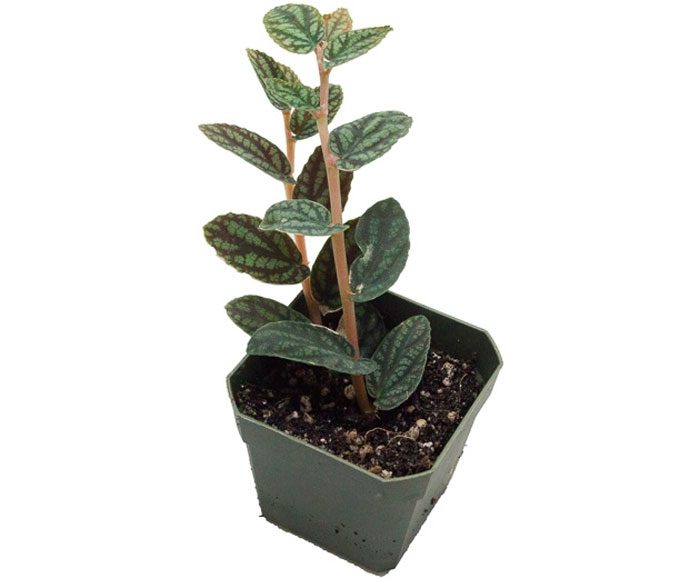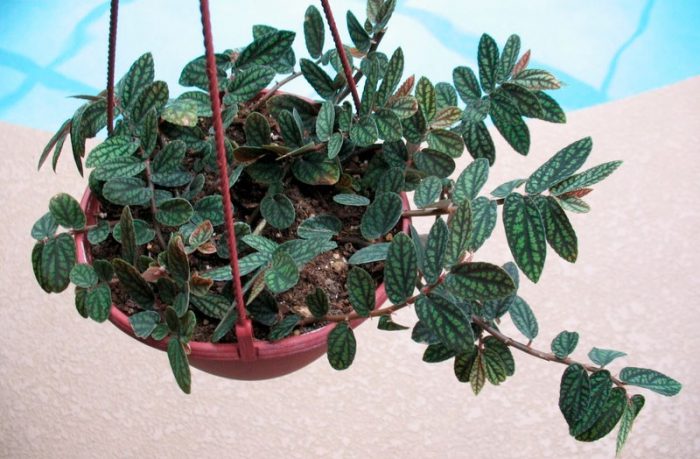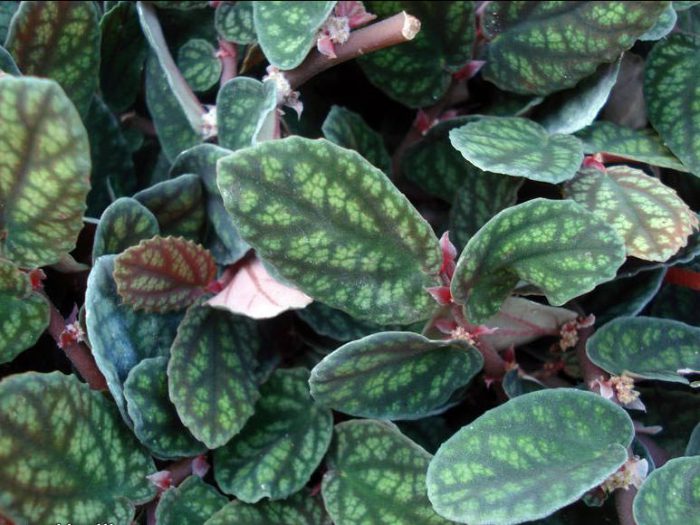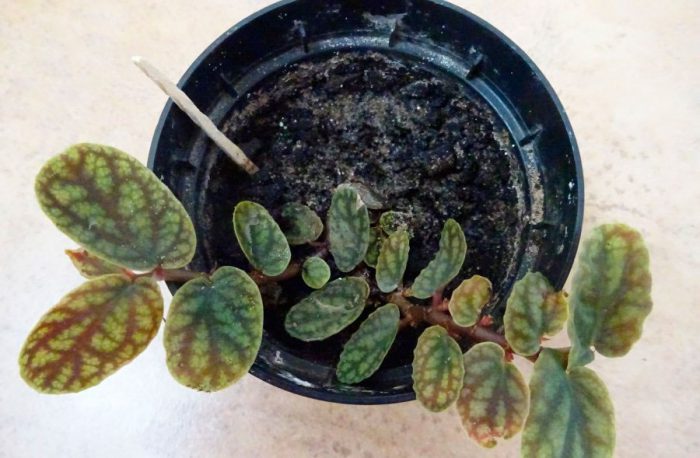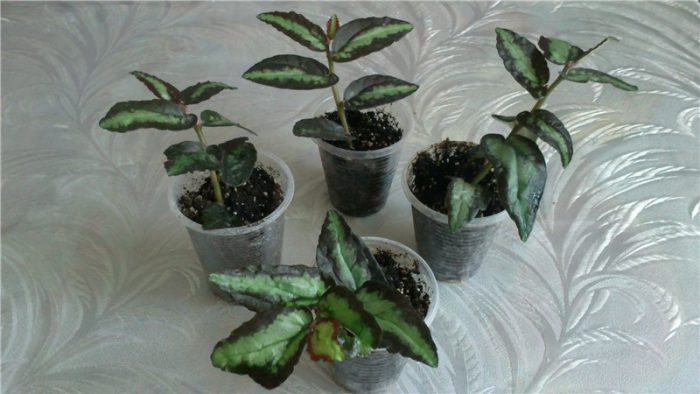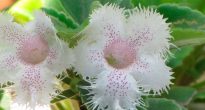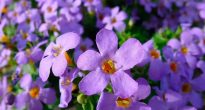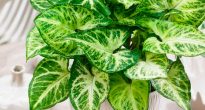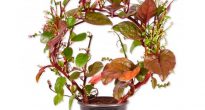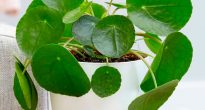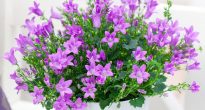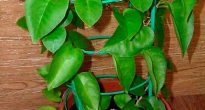Kind of like pellionia is directly related to the family of nettle (Urticaceae). In this genus, there are about 50 species of herbaceous plants that are perennials. They can have both erect and creeping stems, which are strongly branching at the base. In nature, they can be found in the tropical zones of Polynesia, as well as East Asia. Only a couple of species of this plant can be grown at home. And all because the conditions for their cultivation there are extremely unfavorable.
Content
Pellionia daveauana
It has naked, rather thick shoots, painted in a pale brown color, and on them are alternately asymmetric broad-lanceolate leaves with heart-shaped bases, as well as short cuttings. The surface of the leaves is smooth, slightly gorbate, and they reach 4-6 centimeters in length. They have an unusual and beautiful color. A rather wide, longitudinal stripe of a pale, greenish-grayish color runs right in the center. And along the edge of the leaves are painted in a dark, almost black, shimmering purple color. The seamy side of the leaf is green-gray. On the creeping stems, roots are formed in places where the nodes touch the soil surface, due to this, a fairly rapid growth in all directions occurs.
Beautiful Pellionia (Pellionia pulchra)
It has a smaller size compared to Pellionia Davo, and also a completely different color. The maximum length of the leaves is 4 centimeters. On the gray-silver face of the leaf, there are dark green stripes along the veins. The seamy side is grayish pink.
Both species have small white-green flowers, collected in loose inflorescences in the form of umbrellas and do not represent any decorative value. Home-grown plants tend to be pruned.
Pellionia care at home
This plant is unpopular among gardeners, despite the fact that it is not very demanding to care for and is often found in specialty stores.
Illumination
The best spot for Pellionia is at the back of a well-lit room. It can grow in the complete absence of sunlight, but in this case, you will need phytolamp lighting. The plant feels fine in partial shade and it is not recommended to get direct sunlight on the foliage.
Temperature regime
He loves warmth, but at the same time the heat negatively affects him. So, in the warm season, the recommended temperature for him is from 20 to 24 degrees. With the onset of the winter period, the temperature is slightly lowered, but it should not be less than 16 degrees.
Reacts well to regular ventilation of the room, but at the same time, Pellionia should be protected from drafts.
How to water
Throughout the year, abundant systematic watering is needed. To do this, use slightly lukewarm and settled water. The soil in the flower pot should be slightly damp at all times, but not wet. Stagnant water in the soil negatively affects the root system.
Humidity
The air humidity needs to be increased. To maintain it at the proper level, you need to pour a little expanded clay or pebbles into the pallet and pour in water. And you also need to spray the foliage at least 2 times a day.
Earth mix
Needs light and nutrient-rich soil. For planting, a commercially available universal flower soil is suitable, into which a small amount of a baking powder should be poured, for example, such as vermiculite, perlite or brick chips. You can also make a dredge with your own hands by mixing humus, leaf and peat soil, as well as coarse sand in a ratio of 1: 2: 1: 1.
Flower pots are low and wide because the root system is close to the soil surface. Don't forget good drainage.
Can grow hydroponically.
Fertilizer
Top dressing is carried out infrequently during active growth once a month. To do this, use a complex fertilizer for ornamental-deciduous plants (use ½ part of the dose from the recommended dosage indicated on the package). In winter, fertilizers are not applied to the soil.
Features of pruning and transplanting
While the Pellionia is young, it is recommended to pinch it to form a more lush crown, but the matured flower does not need it. It grows very quickly and it is recommended to renew the plant after 1–2 years. For these reasons, a transplant is not required.
Reproduction methods
Can be grown from seed and propagated by cuttings. For the cutting, the tops of the stems are cut, while it is worth considering that they must have at least three internodes. It takes root quickly after about a week.
Pests
Most often settles whiteflyas well as aphids. For the preventive purposes of Pellionia, a systematic warm shower is recommended. This will eliminate the need to use chemicals.
Application
It is often used to make flower arrangements or mixes consisting of several different flowers. As a rule, terrariums, florariums, and also bottle gardens are used to create them.
They also grow it as an ampelous plant in hanging pots, as well as as a ground cover plant, while combining it with single large flowers.
Possible problems
Due to improper care, several problems can arise:
- The tips of the leaves dry - low humidity.
- Decay of the root collar and roots - stagnation of water in the soil.
- The color of the leaves has become pale - too much light.
- The shoots are very elongated - little light.

